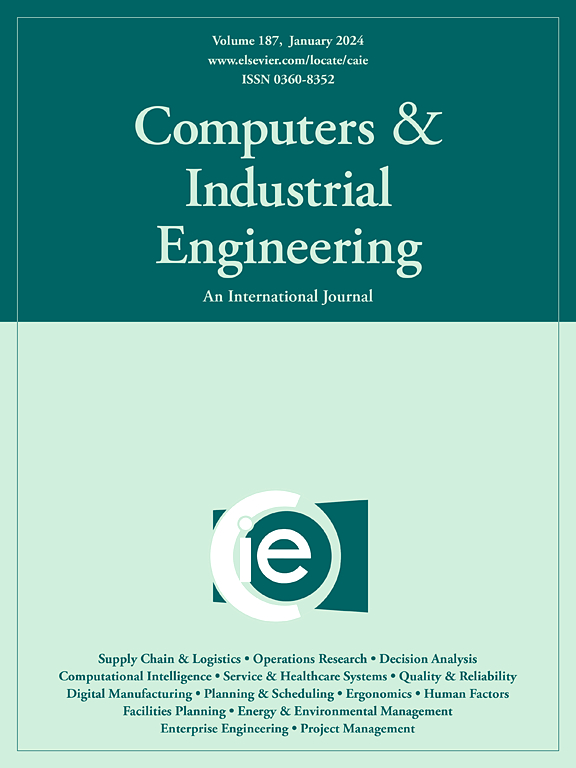优化班轮运输企业碳排放分配
IF 6.5
1区 工程技术
Q1 COMPUTER SCIENCE, INTERDISCIPLINARY APPLICATIONS
引用次数: 0
摘要
海运约占全球每年二氧化碳排放量的3%。为了解决这个问题,欧盟排放交易体系(ETS)要求航运公司为他们排放的每吨二氧化碳付费。为了应对这一规定,班轮运输公司将碳排放成本转嫁给了客户。这些公司通常对每20英尺标准箱(TEU)集装箱征收排放附加费,并根据个别交易计算附加费,这些交易通常包括一个地区内的多个始发目的地(od)对。然而,这种附加费结构不能解释同一交易中od对之间距离的变化。为了解决这一限制,我们提出了一种碳排放分配政策,该政策使用优化方法来分配每个集装箱对的每标箱排放量。该方法结合了od对的最短航行距离和实际航行距离,并将其合并为谐波距离。谐波因子表示所选择的碳排放分配政策。考虑到碳排放分配应针对特定航线,本研究构建了一个多航线的增强型航运网络。在此基础上,我们建立了两种基于od链的模型:一种是有转运的模型,另一种是无转运的模型。这两种模式都旨在使班轮运输公司的利润最大化。这些模型通过使用真实世界和合成航运网络进行的实验进行了验证。结果表明,有转运的模型比没有转运的模型产生更高的利润。在无转运模型下,碳排放分配政策对航运公司的利润影响不大。然而,在转运模型中,选择合适的碳排放分配策略至关重要。本文章由计算机程序翻译,如有差异,请以英文原文为准。
Optimizing carbon emission allocation for liner shipping companies
Maritime shipping accounts for approximately 3% of all annual carbon dioxide () emissions worldwide. To address this, the EU Emissions Trading System (ETS) mandates that shipping companies pay for every ton of they emit. In response to this regulation, liner shipping companies have passed the cost of carbon emissions onto their customers. These companies typically levy an emissions surcharge per twenty-foot equivalent unit (TEU) container and calculate the surcharge based on individual trades, which typically encompass multiple origin–destination (od) pairs within a region. However, this surcharge structure fails to account for variations in distance between od pairs within the same trade. To address this limitation, we propose a carbon emissions allocation policy using an optimization method to allocate emissions per TEU for each od pair. This method incorporates both the shortest sailing distance and the actual traveling distance of the od pair, combining these into a harmonic distance. The harmonic factor represents the chosen carbon emissions allocation policy. Considering that carbon emission allocation should be tailored to specific shipping routes, this study constructs an augmented shipping network of multiple routes. Based on this network, we develop two od-link-based models: one with transshipment and the other without transshipment. Both models aim to maximize the profits of liner shipping companies. The models are validated through experiments conducted using real-world and synthetic shipping networks. The results show that the model with transshipment yields higher profits than the model without. In the model without transshipment, the carbon emission allocation policy has little impact on the profits of shipping companies. However, in the model with transshipment, selecting an appropriate carbon emission allocation policy is critical.
求助全文
通过发布文献求助,成功后即可免费获取论文全文。
去求助
来源期刊

Computers & Industrial Engineering
工程技术-工程:工业
CiteScore
12.70
自引率
12.70%
发文量
794
审稿时长
10.6 months
期刊介绍:
Computers & Industrial Engineering (CAIE) is dedicated to researchers, educators, and practitioners in industrial engineering and related fields. Pioneering the integration of computers in research, education, and practice, industrial engineering has evolved to make computers and electronic communication integral to its domain. CAIE publishes original contributions focusing on the development of novel computerized methodologies to address industrial engineering problems. It also highlights the applications of these methodologies to issues within the broader industrial engineering and associated communities. The journal actively encourages submissions that push the boundaries of fundamental theories and concepts in industrial engineering techniques.
 求助内容:
求助内容: 应助结果提醒方式:
应助结果提醒方式:


